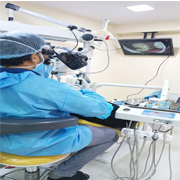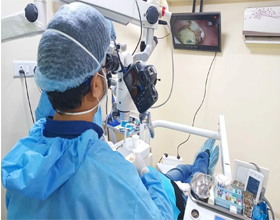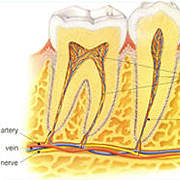
Endodontics concerns itself with treating diseases of the dental pulp. The dental pulp is the name given to the soft tissue that runs through the canal or canals in the middle of the root or roots of a tooth. The pulp consists mainly of nerves and blood vessels and its function is to provide nutrition for a developing tooth and to provide sensory feedback for an erupted tooth.
How does the pulp become diseased? The most common cause of pulp damage is deep decay that reaches the pulp. Other causes of pulp damage include trauma to the teeth, loose fillings resulting in decay, excessive tooth wear and gum disease. These processes can lead to infection and death of the pulp.
The infection may then spread through the opening at the tip of the root to the surrounding bone, resulting in an abscess which may be very painful and cause swelling. Such an abscess may show up on an X-ray of the tooth.
Symptoms of an infected tooth that the patient may be aware of may include pain, especially at night, pain when biting on the tooth and with heat, discolouration of the tooth and swelling and soreness in the gums surrounding the tooth. Sometimes, curiously, there may be no symptoms from an infected tooth at all that the patient is aware of, and this is where regular dental checkups are important in order to identify and treat such teeth before they give rise to symptoms.
Treatment of an infected tooth is by root canal therapy which involves cleaning away of the infected pulp and filling of the root canals permanently. Root canal therapy should be commenced and completed as soon as possible in order to prevent the possibility of the infection around the tooth spreading and causing more widespread and potentially serious infection around the body, manifesting in such things as facial swelling and fever which may occasionally require hospitalization. The localized spread of an abscess is also important and in time, if left untreated, may result in the loss of supporting bone around the root of the tooth and eventually loss of the tooth.
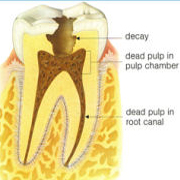
For those patients where swelling and fever are already present, a course of antibiotics may be prescribed. Antibiotics are not a substitute for root canal therapy, for the reason that there is no longer a blood supply to the inside of an infected tooth so that there is no way for the antibiotics to be carried into the inside of such a tooth to eliminate the infection. The purpose of antibiotics is to stop the infection that is outside the tooth from spreading and to help the body fight what is already there.
All root canals in the affected tooth must be treated. The front teeth (incisors and canines) and premolars typically have one or two root canals. Molars usually have three or four. Root canal therapy may be done over a number of visits, typically two or three, in the case of teeth with active or long-standing and extensive infection but sometimes it may be possible to complete the treatment in a single visit if the infection is of recent origin and relatively mild in symptoms.
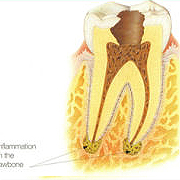
Whatever the choice, Contemporary Smiles is your fully trained and equipped centre for root canal therapy. We have invested heavily in the latest techniques and equipment, such as active variable taper nickel-titanium rotary instrumentation and electronic apex location - fancy words, but cutting-edge designs - ensuring that our success rate in endodontics is equivalent to world's best standard at above 95%.
Rubber dam isolation of your tooth during treatment, in order to keep the tooth clean and dry so that effective sterilization of the root canals may be accomplished, is a routine at our practice, rather than a chore as at many other dental practices.
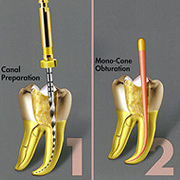
Following root canal therapy, careful restoration of the tooth is of paramount importance. Teeth which have had root canal therapy tend to dry out and become brittle, hence prone to fracture, during chewing. Heavily restored teeth which have had root canal therapy are even more at risk. You have already paid a fair sum for your root canal therapy and the last thing you would want to happen is for such a tooth to break apart during chewing, requiring its removal. The general recommendation is that a tooth which has had root canal therapy and where such a tooth is missing from its structure more than the small access cavity cut for the root canal instrumentation, be restored with a full coverage crown as soon as possible, in order to protect it from fracture. The patient should not bite on the tooth following the root canal therapy until such a tooth has been restored by a crown. In some cases the root filled tooth may lack sufficient remaining visible tooth structure to support a crown. In such a situation, a post may be inserted into the root canal and a foundation or core built up to support the final crown.
At Contemporary Smiles, when we provide you with a quote for root canal therapy, we also routinely quote for a crown at the same time, so you can have peace of mind knowing that your tooth will have a long life in your mouth.
Replacing your tooth, which may have been saved through root canal therapy, with an artificial one, may be a more expensive option than saving the tooth in the first place. Alternatively, the replacement may be less efficient in chewing and biting or it may involve treatment of your adjacent teeth which may harm them. Weighing up the alternatives, you are much better off having the tooth saved through root canal therapy and crowning.
